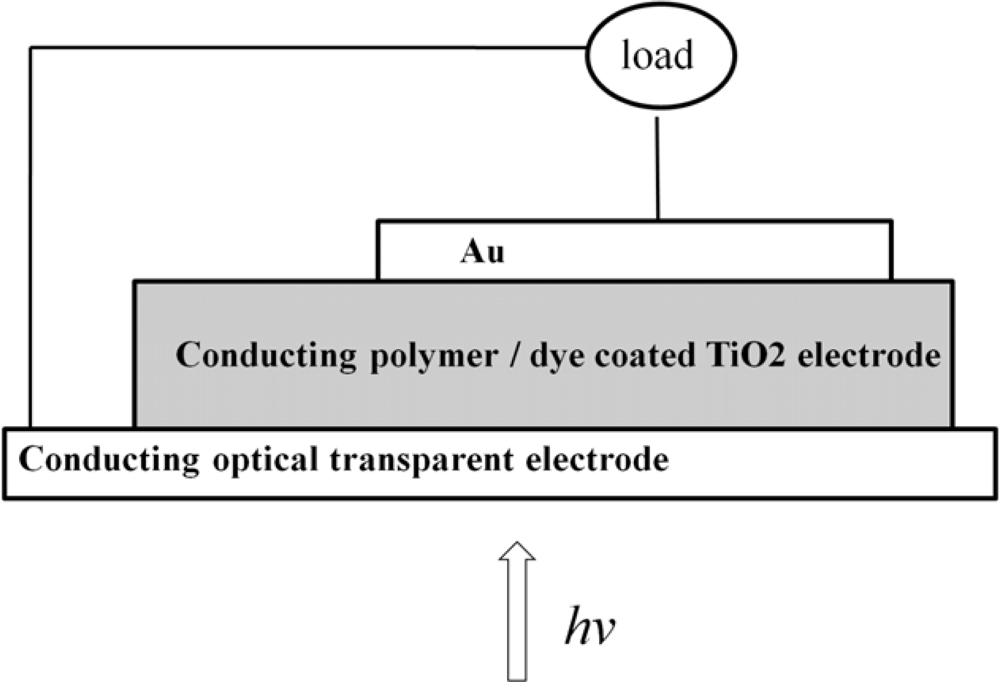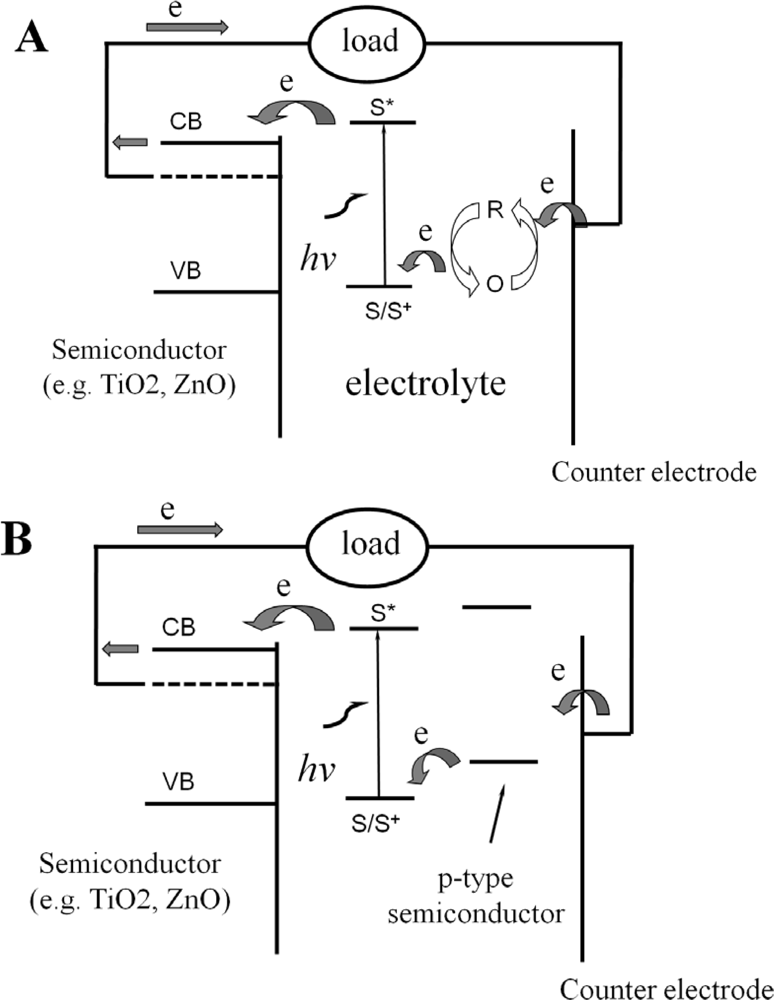Dye Sensitized Solar Cells
Abstract
:1. Introduction
2. Dye Sensitized Solar Cells (DSSCs)
3. Conclusions
References and Notes
- Becquerel, AE. Recherches sur les effets de la radiation chimique de la lumière solaire, au moyen des courants électriques. C R Acad. Sci 1839, 9, 145–149. [Google Scholar]
- West, W. First hundred years of spectral sensitization. Proc. Vogel. Cent. Symp. Photogr. Sci. Eng 1974, 18, 35–48. [Google Scholar]
- Gerischer, H; Tributsch, H. Electrochemische Untersuchungen zur spectraleu sensibilisierung von ZnO-Einkristallen. Ber. Bunsenges. Phys. Chem 1968, 72, 437–445. [Google Scholar]
- Hauffe, K; Danzmann, HJ; Pusch, H; Range, J; Volz, H. New Experiments on the sensitization of zinc oxide by means of the electrochemical cell technique. J. Electrochem. Soc 1970, 117, 993–999. [Google Scholar]
- Myamlin, VA; Pleskov, YV. Electrochemistry of Semiconductors; Plenum Press: New York, NY, USA, 1967. [Google Scholar]
- Hagfeldt, A; Gratzel, M. Light-Induced redox reactions in nanocrystalline systems. Chem. Rev 1995, 95, 49–68. [Google Scholar]
- Wurfel, U; Peters, M; Hinsch, A. Detailed experimental and theoretical investigation of the electron transport in a dye solar cell by means of a three-electrode configuration. J. Phys. Chem. C 2008, 112, 1711–1720. [Google Scholar]
- Hagfeldt, A; Gratzel, M. Molecular photovoltaics. Acc. Chem. Res 2000, 33, 269–277. [Google Scholar]
- O’Regan, B; Gratzel, M. A low-cost, high efficiency solar cell based on dye-sensitized colloidal TiO2 films. Nature 1991, 353, 737–740. [Google Scholar]
- Chen, C; Wang, M; Li, J; Pootrakulchote, N; Alibabaei, L; Ngoc-le, C; Decoppet, JD; Tsai, J; Gratzel, C; Wu, C; Zakeeruddin, SM; Gratzel, M. Highly efficient light-harvesting ruthenium sensitizer for thin-film dye-sensitized solar cells. ACS Nano 2009, 3, 3103–3109. [Google Scholar]
- Gratzel, M. Photovoltaic and photoelectrochemical conversion of solar energy. Phil. Trans. R. Soc. A 2007, 365, 993–1005. [Google Scholar]
- Lee, WJ; Ramasamy, E; Lee, DY; Song, JS. Dye-sensitized solar cells: Scale up and current–voltage characterization. Sol. Energy Mater. Sol. Cells 2007, 91, 1676–1680. [Google Scholar]
- Moser, J. Notiz über Verstärkung photoelektrischer Ströme durch optische Sensibilisirung. Monatsh. Chem 1887, 8, 373. [Google Scholar]
- Vlachopoulos, N; Liska, P; Augustynski, J; Gratzel, M. Very efficient visible light energy harvesting and conversion by spectral sensitization of high surface area polycrystalline titanium dioxide films. J. Am. Chem. Soc 1988, 110, 1216–1220. [Google Scholar]
- Nazeeruddin, MK; Kay, A; Rodicio, I; Humphry-Baker, R; Muller, E; Liska, P; Vlachopoulos, N; Gratzel, M. Conversion of light to electricity by cis-X2bis (2,2′-bipyridyl-4,4′-dicarboxylate) ruthenium(II) charge-transfer sensitizers (X = Cl-, Br-, I-, CN-, and SCN-) on nanocrystalline titanium dioxide electrodes. J. Am. Chem. Soc 1993, 115, 6382–6390. [Google Scholar]
- Nazeeruddin, MK; Pechy, P; Renouard, T; Zakeeruddin, SM; Baker, RH; Comte, P; Liska, P; Cevey, L; Costa, E; Shklover, V; Spiccia, L; Deacon, GB; Bignozzi, CA; Gratzel, M. Engineering of efficient panchromatic sensitizers for nanocrystalline TiO2-Based solar cells. J. Am. Chem. Soc 2001, 123, 1613–1624. [Google Scholar]
- Bach, U; Lupo, D; Comte, P; Moser, JE; Weissortel, F; Salbeck, J; Spreitzer, H; Gratzel, M. Solid-state dye-sensitized mesoporous TiO2 solar cells with high photon-to-electron conversion efficiencies. Nature 1998, 395, 583–585. [Google Scholar]
- Tennakone, K; Kumara, GRRA; Kottegada, IRM; Wijanthana, KGU; Perera, PS. A solid-state photovoltaic cell sensitized with a ruthenium bipyridyl complex. J. Phys. D: Appl. Phys 1998, 31, 1492–1496. [Google Scholar]
- Hagen, J; Schaffrath, W; Otschik, P; Fink, R; Bacher, A; Schmidt, HW; Haarer, D. Novel hybrid solar cells consisting of inorganic nanoparticles and an organic hole transport material. Synth. Met 1997, 89, 215–220. [Google Scholar]
- O’Regan, B; Schwartz, DT. Efficient photo-hole injection from adsorbed cyanine dyes into electrodeposited Copper(I) Thiocyanate thin films. Chem. Mater 1995, 7, 1349–1354. [Google Scholar]
- O’Regan, B; Schwartz, DT; Zakeeruddin, SM; Gratzel, M. Electrodeposited nanocomposite n-p heterojunctions for solid-state dye-sensitized photovoltaics. Adv. Mater 2000, 12, 1263–1267. [Google Scholar]
- Zaban, A; Diamant, Y. Electrochemical deposition of organic semiconductors on high surface area electrodes for solar cells. J. Phys. Chem. B 2000, 104, 10043–10046. [Google Scholar]
- Murakoshi, K; Kogure, R; Wada, Y; Yanagida, S. Fabrication of solid-state dye-sensitized TiO2 solar cells combined with polypyrrole. Sol. Energy Mater. Sol. Cells 1998, 55, 113–125. [Google Scholar]
- Somani, PR; Radhakrishnan, S. Effect of solid polymer electrolyte on the sensitization of photocurrents in solid-state electrochemical cells using conducting polypyrrole. J. Solid State Electrochem 2004, 15, 75–79. [Google Scholar]
- Shin, WS; Kim, SC; Lee, SJ; Jeon, HS; Kim, MK; Naidu, BVK; Jin, SH; Lee, JK; Lee, JW; Gal, YS. Synthesis and photovoltaic properties of a low-band-gap polymer consisting of alternating thiophene and benzothiadiazole derivatives for bulk-heterojunction and dye-sensitized solar cells. J. Poly. Sci. A Poly. Chem 2007, 45, 1394–1402. [Google Scholar]
- Snaith, HJ; Moule, AJ; Klein, C; Meerholz, K; Friend, RH; Grätzel, M. Efficiency enhancements in solid-state hybrid solar cells via reduced charge recombination and increased light capture. Nano Letters 2007, 7, 3372–3376. [Google Scholar]
- Zhang, X; Yang, H; Xiong, HM; Li, FY; Xia, YY. A quasi-solid-state dye-sensitized solar cell based on the stable polymer-grafted nanoparticle composite electrolyte. J. Power Sources 2006, 160, 1451–1455. [Google Scholar]
- Lu, SL; Koeppe, R; Gunes, S; Sariciftci, NS. Quasi-solid-state dye-sensitized solar cells with cyanoacrylate as electrolyte matrix. Sol. Energ. Mater. Sol. C 2007, 91, 1081–1086. [Google Scholar]
- Lan, Z; Wu, J; Lin, J; Huang, M. Quasi-solid-state dye-sensitized solar cells with a novel efficient absorbent for liquid electrolyte based on PAA–PEG hybrid. J. Power Sources 2007, 164, 921–925. [Google Scholar]
- Galinski, M; Lewandowski, A; Stepniak, I. Ionic liquids as electrolytes. Electrochim. Acta 2006, 51, 5567–5580. [Google Scholar]
- Johnson, KE. What's an Ionic Liquid? Interface 2007, 16, 38–41. [Google Scholar]
- Yamanaka, N; Kawano, R; Kubo, W; Masaki, N; Kitamura, T; Wada, Y; Watanabe, M; Yanagida, S. Dye-Sensitized TiO2 solar cells using imidazolium-type ionic liquid crystal systems as effective electrolytes. J. Phys. Chem. B 2007, 111, 4763–4769. [Google Scholar]
- Wang, P; Zakeeruddin, SM; Moser, JE; Gratzel, M. A new ionic liquid electrolyte enhances the conversion efficiency of dye-sensitized solar cells. J. Phys. Chem. B 2003, 107, 13280–13285. [Google Scholar]
- Wang, M; Xiao, X; Zhou, X; Li, X; Lin, Y. Investigation of PEO-imidazole ionic liquid oligomer electrolytes for dye-sensitized solar cells. Sol. Energ. Mater. Sol. C 2007, 91, 785–790. [Google Scholar]
- Fabregat-Santiago, F; Bisquert, J; Palomares, E; Otero, L; Kuang, D; Zakeeruddin, SM; Gratzel, M. Correlation between photovoltaic performance and impedance spectroscopy of dye-sensitized solar cells based on ionic liquids. J. Phys. Chem. C 2007, 111, 6550–6560. [Google Scholar]
- Ikeda, N; Miyasaka, T. Plastic and solid-state dye-sensitized solar cells incorporating single-wall carbon nanotubes. Chem. Lett 2007, 3, 466–469. [Google Scholar]
- Lee, TY; Alegaonkar, PS; Yoo, JB. Fabrication of dye sensitized solar cell using TiO2 coated carbon nanotubes. Thin Solid Films 2007, 515, 5131–5135. [Google Scholar]
- Kongkanand, A; Dominguez, RM; Kamat, PV. Single wall carbon nanotube scaffolds for photoelectrochemical solar cells. capture and transport of photogenerated electrons. Nano Lett 2007, 7, 676–680. [Google Scholar]
- Wang, X; Zhi, L; Mullen, K. Transparent, conductive graphene electrodes for dye-sensitized solar cells. Nano Letters 2008, 8, 323–327. [Google Scholar]
- Bach, U; Kruger, J; Gratzel, M. Organic photovoltaics. SPIE Pro. San Diego 2000, 4108, 1–7. [Google Scholar]
- Huang, SY; Schlichthorl, G; Notzik, AJ; Gratzel, M; Frank, AJ. Charge recombination in dye-sensitized nanocrystalline TiO2 solar cells. J. Phys. Chem. B 1997, 101, 2576–2582. [Google Scholar]
- Armstrong, AR; Armstrong, G; Canales, J; Garcia, R; Bruce, PG. Lithium-Ion intercalation into TiO2-B nanowires. Adv. Mater 2005, 17, 862–865. [Google Scholar]
- Reddy, MA; Kishore, MS; Pralong, V; Caignaert, V; Varadaraju, UV; Raveau, B. Room temperature synthesis and Li insertion into nanocrystalline rutile TiO2. Electrochem. Commun 2006, 8, 1299–1303. [Google Scholar]
- Woodward, PM. Complex perovskites: A chessboard at the nanoscale. Nat. Mater 2007, 6, 549–551. [Google Scholar]
- Hairima, Y; Kawabuchi, K; Kajihara, S; Ishii, A; Ooyama, Y; Takeda, K. Improvement of photovoltages in organic dye-sensitized solar cells by Li intercalation in particulate TiO2 electrodes. Appl. Phys. Lett 2007, 90, 103517–103519. [Google Scholar]
- Enright, B; Redmond, G; Fitzmaurice, D. Spectroscopic determination of flatband potentials for polycrystalline titania electrodes in nonaqueous solvents. J. Phys. Chem 1993, 97, 1426–1430. [Google Scholar]
- Tsubomura, H; Matsumura, M; Nomura, Y; Amamiya, T. Dye sensitised zinc oxide: Aqueous electrolyte platinum photocell. Nature 1976, 261, 402. [Google Scholar]
- Rensmo, H; Keis, K; Lindstrom, H; Sodergren, S; Solbrand, A; Hagfeldt, A; Lindquist, SE; Muhammed, M. High light-to-energy conversion efficiencies for solar cells based on nanostructured ZnO electrodes. J. Phys. Chem. B 1997, 101, 2598–2561. [Google Scholar]
- Meulenkamp, EA. Electron transport in nanoparticulate ZnO films. J. Phys. Chem. B 1999, 103, 7831–7838. [Google Scholar]
- Hagfeldt, A; Gratzel, M. Light-Induced redox reactions in nanocrystalline systems. Chem. Rev 1995, 95, 49–68. [Google Scholar]
- Suh, DI; Lee, SY; Kim, TH; Chun, JM; Suh, EK; Yang, OB; Lee, SK. The fabrication and characterization of dye-sensitized solar cells with a branched structure of ZnO nanowires. Chem. Phys. Lett 2007, 442, 348–353. [Google Scholar]
- Unalan, HE; Wei, D; Suzuki, K; Dalal, S; Hiralal, P; Matsumoto, H; Imaizumi, S; Minagawa, M; Tanioka, A; Flewitt, AJ; Milne, WI; Amaratunga, GAJ. Photoelectrochemical cell using dye sensitized zinc oxide nanowires grown on carbon fibers. Appl. Phys. Lett 2008, 93, 133116–133118. [Google Scholar]
- Wei, D; Unalan, HE; Han, D; Zhang, Q; Niu, L; Ryhanen, T; Amaratunga, GAJ. A solid-state dye-sensitized solar cell based on a novel ionic liquid gel and ZnO nanoparticles on a flexible polymer substrate. Nanotechnology 2008, 19, 424006–424010. [Google Scholar]
- Canham, LT. Silicon quantum wire array fabrication by electrochemical and chemical dissolution of wafers. Appl. Phys. Lett 1990, 57, 1046–1050. [Google Scholar]
- Kelly, JJ; Vanmaekelbergh, D. Electrochemisrty of Nanomaterials; Hodes, G, Ed.; WILEY-VCH: Weinheim, Germany, 2001; Chapter 4; pp. 103. [Google Scholar]
- Kelly, JJ; Vanmaekelbergh, D. Charge carrier dynamics in nanoporous photoelectrodes. Electrochim. Acta 1998, 43, 2773–2780. [Google Scholar]
- Colvin, VL; Goldstein, AN; Alivisatos, AP. Semiconductor nanocrystals covalently bound to metal surfaces with self-assembled monolayers. J. Am. Chem. Soc 1992, 114, 5221–5230. [Google Scholar]
- Miyake, M; Matsumoto, H; Nishizawa, M; Sakata, T; Mori, H; Kuwabata, S; Yoneyama, H. Characterization of covalently immobilized Q-CdS particles on Au(111) by scanning tunneling microscopy and tunneling spectroscopy with high reproducibility. Langmuir 1997, 13, 742–746. [Google Scholar]
- Nakanishi, T; Ohtani, B; Uosaki, K. Fabrication and characterization of CdS-Nanoparticle mono- and multilayers on a self-assembled monolayer of alkanedithiols on gold. J. Phys. Chem. B 1998, 102, 1571–1577. [Google Scholar]
- Hu, K; Brust, M; Bard, AJ. Characterization and surface charge measurement of self-assembled CdS nanoparticle films. Chem. Mater 1998, 10, 1160–1165. [Google Scholar]
- Drouard, S; Hickey, SG; Riley, JD. CdS nanoparticle-modified electrodes for photoelectrochemical studies. Chem. Commun 1999, 1, 67–68. [Google Scholar]
- Ogawa, S; Ran, FF; Bard, AJ. Scanning tunneling microscopy, tunneling spectroscopy, and photoelectrochemistry of a film of Q-CdS particles incorporated in a self-assembled monolayer on a gold surface. J. Phys. Chem 1995, 99, 11182–11189. [Google Scholar]
- Ogawa, S; Hu, K; Fan, FRF; Bard, AJ. Photoelectrochemistry of films of quantum size lead sulfide particles incorporated in self-assembled monolayers on gold. J. Phys. Chem. B 1997, 101, 5707–5711. [Google Scholar]
- Chen, D; Wang, G; Lu, W; Zhang, H; Li, J. Photoelectrochemical study of organic–inorganic hybrid thin films via electrostatic layer-by-layer assembly. Electrochem. Commun 2007, 9, 2151–2156. [Google Scholar]


© 2010 by the authors; licensee Molecular Diversity Preservation International, Basel, Switzerland. This article is an open-access article distributed under the terms and conditions of the Creative Commons Attribution license (http://creativecommons.org/licenses/by/3.0/).
Share and Cite
Wei, D. Dye Sensitized Solar Cells. Int. J. Mol. Sci. 2010, 11, 1103-1113. https://doi.org/10.3390/ijms11031103
Wei D. Dye Sensitized Solar Cells. International Journal of Molecular Sciences. 2010; 11(3):1103-1113. https://doi.org/10.3390/ijms11031103
Chicago/Turabian StyleWei, Di. 2010. "Dye Sensitized Solar Cells" International Journal of Molecular Sciences 11, no. 3: 1103-1113. https://doi.org/10.3390/ijms11031103



